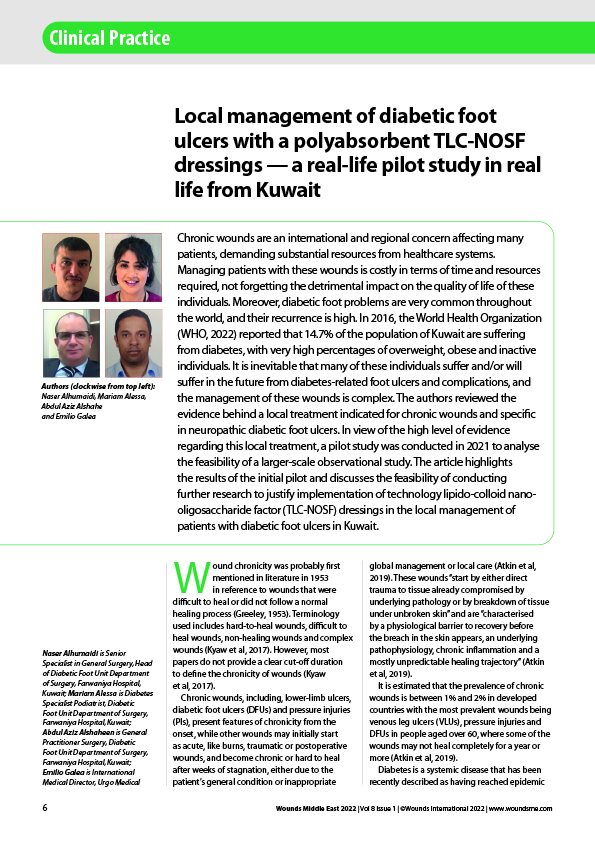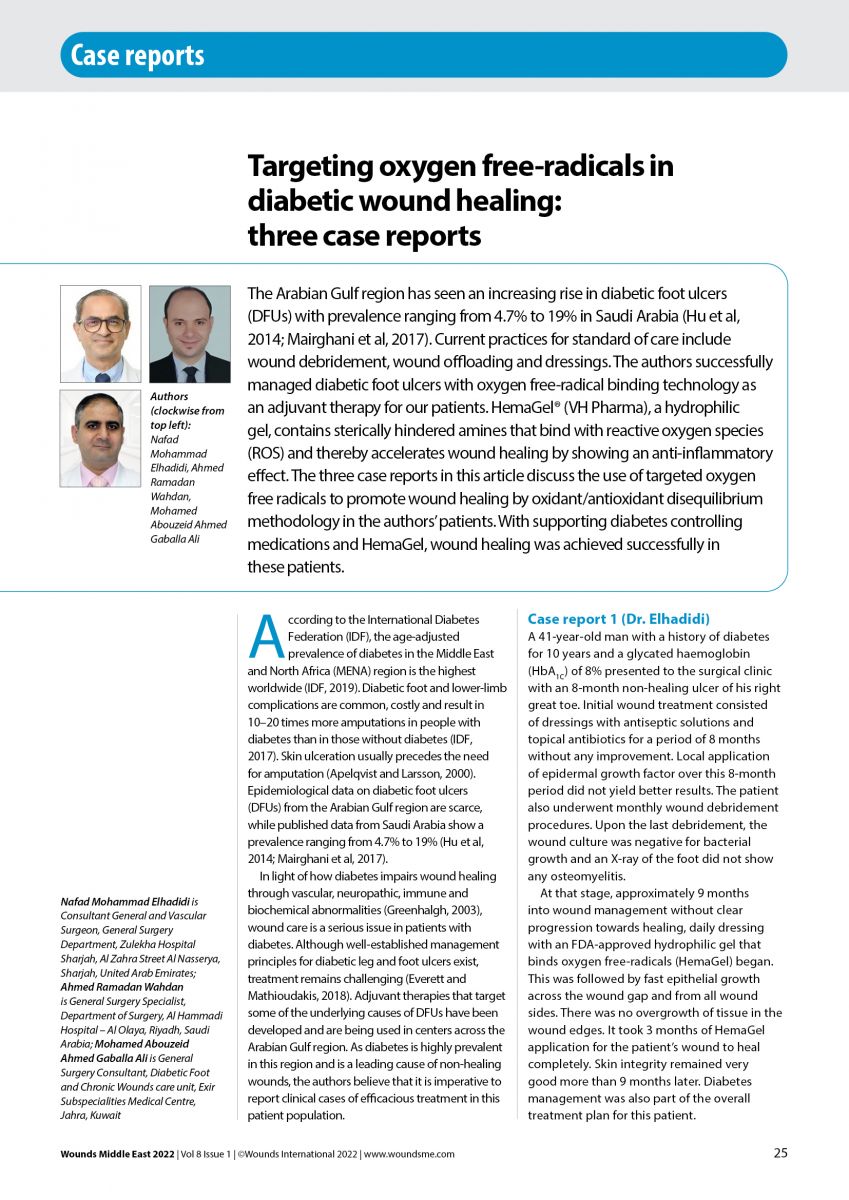Diabetic foot problems are common and vary considerably in both aetiology and clinical presentation (Jeffcoate et al, 2006). Problems include nerve damage or dysfunction, increased arteriosclerosis, and skin and joint changes that can often lead to ulceration and amputation (Boulton et al, 2008). Between 85–90% of lower extremity amputations in people with diabetes are preceded by ulceration (Pecoraro et al, 1990).
Despite advances in wound care and healthcare systems, a lower extremity amputation occurs every 20 seconds somewhere in the world (Boulton et al, 2005; International Diabetes Federation, 2015). Although a lower extremity amputation is a good outcome in certain circumstances, the majority may be unnecessary and could be prevented by well-structured specialised services and a dedicated multidisciplinary foot care team (Traunter et al, 2007; Krishnan et al, 2008; Ikonen et al, 2010; Moxey et al, 2011; Holman et al, 2012; Jørgensen et al, 2014).
Unless patients are regularly screened, know and understand their risk status, implement directed self-care and can access unhindered emergency care, there will not be significant improvements in ulcer and amputation prevention.
Diabetic foot screening can be undertaken by any trained healthcare professional or ancillary staff using evidence-based tools and guidelines. This process should identify those most at risk of foot ulceration and targeted foot care interventions. It is a time for optimised, interactive foot health education, allowing individualised goal setting and guidance for self foot care.
Foot screening is directed at identifying who is at risk of developing a foot ulcer. This process should be simple, quick and reliable, using validated clinical tools to determine risk factors (Crawford et al, 2011), and repeated regularly to identify future changes. The level of expertise needed to perform foot screening and apply a stratified risk code is less than that required for a diabetic foot assessment. However adequate, proper and structured training must be given, audited and reviewed to ensure consistency, validity and to identify any poor screening techniques (Leese et al, 2007; 2008).
It must be stressed that clinical screening and assessment are completely different:
Screening is a process for evaluating the possible presence of a particular problem (in this case, foot ulcer risk).
Assessment is a process for defining the nature of that problem and determining a diagnosis and formulating specific treatments and interventions for the problem.
Screening involves identifying the clinical and social factors that are directly associated in the causal pathway for ulceration, such as loss of protective sensation, peripheral arterial disease, deformity, callus, previous ulceration, inability to self care, inadequate footwear and poor sight (Leese at al 2008). The link between foot ulceration and lower extremity amputations is clear, with between 85–90% being preceded by a foot ulcer (Pecoraro et al, 1990; Global Lower Extremity Amputation Study Group, 2000). Thus, identifying those at risk and implementing prevention strategies should help to prevent ulceration and reduce unnecessary lower extremity amputations.
Table 1 shows ulcer risk factors listed in priority order. Risk factors are cumulative, so the more factors present, the higher the risk for an event. Examples of how to identify and stratify risk following screening are shown in Tables 2 and 3. Adopting the traffic light style is a good patient education tool, subliminally indicating that red and orange represent “danger” and green “safety”. The screening actions are very clear and effective in the traffic light model (Leese et al, 2011), whereas the consensus guidelines model from the International Working Group on the Diabetic Foot is open to varied interpretation and thus possible confusion.
Previous ulceration or amputation
Previous ulceration or amputation is the highest risk, with ulcer recurrence or relapse as high as 30–40% within 12 months (Bus et al, 2013; Pound et al, 2013), compared with an annual incidence of 7.5% for first ulcers in people with neuropathy (Abbott et al, 2002). This is a standalone risk factor risk for ulceration.
Identifying a previous amputation is generally straightforward, but it may not be in some cases, such as a partial amputation of a lesser toe.
Previous ulceration may not be obvious and obtaining this information may be difficult because patients frequently dismiss easily healed small ulcers, blisters and burns. Additionally, patients may trivialise ulcers due to fear, anxiety or denial. A patient who fails to recognise their own ulcer history highlights a failure in foot health education.
A very thorough foot inspection for scar tissue is essential. It may be difficult to spot scar tissue over the dorsal surfaces of toe joints and between the toes [Figure 1].
Peripheral neuropathy
Diabetic peripheral neuropathy is symmetrical and distal, affecting sensory, autonomic and motor nerve fibres in a “glove and stocking” distribution (Baker et al, 2005).
Sensory neuropathy
Sensory neuropathy is characterised by an inability to detect sensations such as light touch, vibration, hot or cold and pain. Inability to feel protective pain sensations can lead to unnoticed injuries,such as burns, cuts and shoe rubs, that quickly progress to foot ulceration (Baker and Kenny, 2014).
Loss of protective sensation
When screening for loss of protective sensation, the aim is to determine if there is an impaired ability to feel stimuli that are strongly associated with ulcer risk. The screening tools used are simple, reliable, reproducible and easy to use with little training and have been validated for determining increased ulcer risk.
Tools and methods
10 g monofilament
Inability to feel a 10 g monofilament is associated with a seven-fold risk for ulceration (Mayfield and Sugarman, 2000; Miranda-Palma et al, 2005). The 10 g monofilament is the most commonly used screening tool. They are widely available, cheap, reliable and easy to use, with very little training or expertise required. However, it is important, to follow a good standardised operating procedure in order to avoid erroneous results (Schoen et al, 2016).
Not all deliver 10 g force. One study found that the 10 g monofilament manufactured by Bailey Instruments and Owen Mumford were the most reliable at delivering 10 g force (Booth and Young, 2000).
Technique
Before every screening session, buckle the 10 g monofilament several times to remove residual stiffness, ensuring 10 g force is delivered. It should be allowed to rest after 10 tests and renewed regularly (approximately every 6 months).
Explain what are you doing and why as this a golden opportunity for reinforcing education.
Apply the monofilament to the patient’s inner forearm, so that the sensation of the monofilament can be experienced
Then ask the patient to close their eyes say “yes” every time the monofilament is felt. Ensure that no one prompts the patient during testing and only the patient’s voice is heard.
The monofilament must be placed at 90 degrees to the skin surface.
It should be applied, held and released in a controlled and gentle manner for 1–2 seconds during the application, engagement and removal stages.
When applied and held, the monofilament should buckle about 1 cm from the horizontal [Figure 2].
It must not “wiggle” or slide during testing.
Avoid callused or scar tissue and areas of gross oedema
Inability to detect one or more sites in each foot indicates sensory deficit and increased ulcer risk.
Record and re-check any sites with no response.
Which are the best sites?
Callused, indurated or scarred areas should be avoided. Literature cites between 1–14 testing sites per foot (Baker et al, 2005), so it can be confusing about where to test. Consensus documents suggests either the plantar surface of first toes, third and fifth metatarsal heads (Feng et al, 2011), first toe, first and fifth metatarsal heads (Schaper et al, 2016),
We suggest testing the tips of the first, third, and fifth toes in random order. The rationale for our recommendations are that diabetic neuropathy is distal in onset, thus the toes would be first to be affected.
Testing the heel or arch does not add any information to the screening data and is unnecessary and time consuming.
Vibration perception
Loss of vibration sense to a 128-Hz tuning
fork is associated with increased ulcer risk (Singh et al, 2005; Abbott et al, 2002). It is easily used, readily available and cheap. Other validated tools include the neurothesiometer and VibraTip devices.
A neurothesiometer is a handheld device that gives semi-quantitative assessment of vibration perception threshold measure in volts. A response value of ≥25 volts is associated with 7.7 times increased risk for ulceration (Young et al, 1994; Armstrong et al, 1998) They are expensive and generally is used in research or specialist units.
The VibraTip is a small, pocket-sized battery-powered device that is quick, simple and easy to use. It replicates a 128-Hz tuning fork and is used similarly on the first toe. It has almost identical performance characteristics to a 10 g monofilament, tuning fork and neurothesiometer (Baker, 2012; Bowling et al, 2012; Bracewell et al, 2012).
How to use a 128-Hz tuning fork
Hold it by gripping the flat-ridged area at its base between your thumb and forefinger [Figure 3].
The thumb and forefinger press the limbs of the tuning fork together at its tip and then are pulled away sharply. The tuning fork limbs will
now resonate.
Place the flat base of the tuning fork on a bony part of the patient’s wrist or elbow and ask them what they feel. They should indicate they
sense vibration.
Ask the patient to close their eyes and to say when they feel anything and what they feel.
Excite the tuning fork plate and gently place it on the tip of the big toe. Record if the patient
feels vibration.
Determine whether they feel pressure, cold or vibration.
A Vibratip™ is used like a tuning fork but is activated by squeezing the body of the device between the operator’s thumb and forefinger.
Common testing mistakes:
Prompting the patient for a response by asking “can you feel anything?”
Prodding or wiggling the 10 g monofilament.
Family or carers trying to help by prompting a response “did you feel that?”
Exciting tuning fork incorrectly — no sound should be made so as not to alert the patient that the test will take place.
Ensuring the patient feels vibration, not
the applied pressure or cold from the placed tuning fork.
Autonomic neuropathy
Sympathetic nerves are responsible for innervating sweat glands, thereby maintaining good skin moisture. They also control blood flow by arterial wall vasoconstriction or relaxation and regulate flow between the arteries and veins via the arteriovenous anastomoses.
Observation is the main method of screening, although there are some devices which detect abnormal sweat gland activity. Typically, feet have very dry, warm skin, are slightly oedematous with strong or “bounding” foot pulses. Very dry skin becomes inelastic, so it is common to find skin fissures [Figure 4], particularly on the borders of the heel (Baker et al, 2005).
Motor neuropathy
This late complication of diabetes manifests as a high arch foot with clawing or retraction of the toes with “hollowing out” between the extensor tendons whilst the patient is standing.
Ankle tendon reflexes can be examined, but this is difficult to do and perhaps best excluded.
Peripheral arterial disease
Annual screening for peripheral arterial disease (PAD) is very important because people with diabetes have a fourfold risk of coronary heart disease and cerebrovascular disease (Heald et al, 2006; Mueller et al, 2014). Additionally, PAD significantly increases the risk of mortality and lower extremity amputation (Mueller et al, 2014).
Screening should involve:
Identification of symptoms related to ischaemia.
Obtaining a related history and physical examination for clinical manifestations of ischaemia.
Palpation of foot pulses in both feet.
Be aware that the presence of a pulse does not exclude significant PAD, so if a foot looks ischaemic it probably is (Rivers et al, 1990). Abnormal findings should be referred for formal assessment.
Pulse palpation
Pulse palpation is the main method used for screening. Although a hand-held Doppler can be used, this only serves to confuse. Remember screening is different to assessment — thus simply recording whether a pulse is present or absent is sufficient. Although there are three arteries that enter the foot, only two of these are examined: the dorsalis pedis and posterior tibial.
Place your first and second fingers lightly on the patient’s skin overlying the pulse site you are examining [Figure 5]. You should feel a regular light beating under the pulps of your fingers. If you cannot feel a pulse, move your fingers slightly to the adjacent skin to try to locate one. If you still cannot feel a pulse, try the next site. Then return to this one, try again and record your findings as “present” or “absent”. Present means at least one pulse can be felt in each foot, absent means no pulses can be felt in each foot. This technique does require practice, so it is sensible to be mentored by an experienced clinician.
Reasons for difficulty in obtaining a pulse can be due to oedema, poor technique, abnormal position of arteries or diseased or absent arteries.
Symptoms of PAD include intermittent claudication (pain in leg muscles when walking) or rest pain at night. However, these symptoms may not be present due to neuropathy.
The skin may appear wrinkled, atrophic and impoverished, with a loss of substance. Dark skin may appear darker compared with neighbouring skin.
Foot deformity
A simple definition is “a foot that cannot be accommodated in everyday shoes without distortion”. Most common deformities are clawed toes [Figure 6], hammer toes and bunions. Where deformities are gross, it may be worthwhile considering elective corrective surgery to reduce ulceration risk.
Callus
Thick plantar callus is a common feature of a neuropathic foot. In the neuroischaemic foot, callus is thin, dry, glassy and hard [Figure 7]. Callus in neuropathic patients is strongly associated with ulceration, and its removal significantly reduces this risk. (Young et al, 1992; Murray et al, 1996). The presence of bloodstained callus is highly predictive of ulceration (Rosen et al, 1985; Harkless et al, 1987), and is a clinical emergency that requires urgent attention.
Inability to self-care
This is a frequently overlooked risk factor for foot ulceration. Involving a patient’s active carer(s) is essential when providing foot health advice, but do not exclude the patient.
Ill-fitting footwear
This is possibly one of the most common extrinsic causes of foot ulceration, especially in the elderly. However, addressing footwear problems is very difficult due to factors such as fashion, finance, perceived comfort and ability to bend. Footwear education must address these issues first.
Dry skin – xeroderma
This is predominately due to autonomic neuropathy, PAD and ageing causing a loss of skin elasticity, thus increasing the risk of fissures and potential infection. Dry skin maybe perceived as insignificant and is often not managed well. It is best treated by once or twice daily use of a urea-based moisturiser.
Fungal skin infections
Commonly these present as interdigital fissuring, flaking, vesicular eruptions in the foot arch and intense itching [Figure 8]. With onychomycosis, the nails may be thickened, discoloured, friable and deformed [Figure 9].
Fungal skin infections are not a primary cause of foot ulceration, but they increase the risk for subsequent bacterial infection. Therefore, patients are classed as high ulcer risk until the skin infection is cleared.
Injury
This cannot be easily foreseen except where footwear is ill-fitting. Additionally, not walking barefoot in hot environments, e.g. beaches, will help prevent unperceived burns.
Conclusion
There is little point in foot screening if prevention steps are not implemented, maintained and reviewed. Some of the main risk factors discussed above can be influenced, modified or reduced, while others cannot. Targeting those that can be modified is clearly where efforts should be concentrated, for example, regularly reducing callus in neuropathic patients or accommodating deformity in footwear. Although this sounds simple, it is frequently trivialised or overlooked, but it is a keystone of ulcer prevention or relapse.
Tables 4 and 5 illustrate broad actions following foot screening. The traffic light model adapted from Leese et al (2006) is more direct regarding implementation steps, whereas the International Working Group on the Diabetic Foot model (Schaper et al, 2016) simply suggests follow-up periods with no designated actions.
Diabetic foot screening is easily adopted into clinical practice. It can be undertaken by any healthcare professional or trained personnel. The tools to identify risk are easy to use, reliable and robust.
It must be stressed that screening without implementation of preventative foot care strategies for those deemed at risk is futile. Finally, it is important that screened patients should be told their risk status and their preventative care plan.



